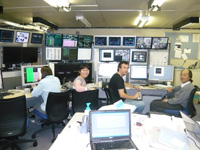 |
 |
|||||||||||||
|
|||||||||||||
|
|||||||||||||
|
In June, a lot of Chinese students graduate from different schools. Sha Bai, a PhD student from the Institute of High Energy Physics (IHEP), is one of them. “I enjoy my research work very much. I like ATF2, ILC and CLIC a lot,” said Bai, who just received her doctoral degree in June 2010 working on ATF2 (Accelerator Test Facility 2) at KEK in Japan, with the goal to reach 37-nanometre vertical beam size at the interaction point, both in beam optics and experimental work.
“During her PhD thesis study, she played an important role in the ATF2 international collaboration, representing Chinese participation in addition to hardware works as such ATF2 quadrupoles and dipoles from IHEP,” said Jie Gao, professor at IHEP and new Chairman of Asian ILC Steering Committee. Bai joined in the ILC group of IHEP, of which the leader is Professor Jie Gao in September 2006. A year later, after successfully obtaining the Eiffel scholarship by the French Ministry of Foreign and European Affairs in the framework of the France China Particle Physics Laboratory (FCPPL), Bai spent ten months at LAL, Orsay under the guidance of Philip Bambade on the ATF2 project. “During the research work in France, she pushed the ATF2 minimum beam vertical size from 37 nanometres to 20 nanometres, which raised great interest from the CLIC group at CERN and induced them to propose a joint R&D programme at ATF2 both for ILC and CLIC,” said Jie Gao. With beam dynamics optimisation results at hand, Bai went to KEK twice for a total of eight months in the ATF2 group headed by Toshiaki Tauchi. “When Bai arrived at KEK, instruments such as beam position monitors and the interaction point (IP) beam size monitor (called "Shintake monitor") were not fully calibrated at ATF2. Although she found some discrepancies during that early period, she succeeded in developing a basic tool to evaluate a consistency in the beam parameters measured at the upstream of the final focus system and at the IP.” said Tauchi. During these two periods of working abroad, Bai became familiar with the international collaboration on which ILC is based, and also got familiar with French and Japanese cultures. In June 2010, just after her graduation, Bai was hired as a staff of ILC group at IHEP, and she will continue working on ATF2 and linear colliders. “It is immediately after she attained a doctorate degree that she was employed at IHEP, China. Bai has a strong mind to get things done,” said Tauchi. “Bai is a hard-working and collaborative person with responsibility, her jointing IHEP ILC group is very important for Chinese continuous participation in ATF2 collaboration and contribution,” said Jie Gao. -- Min Zhang |
|||||||||||||
| © International Linear Collider |
